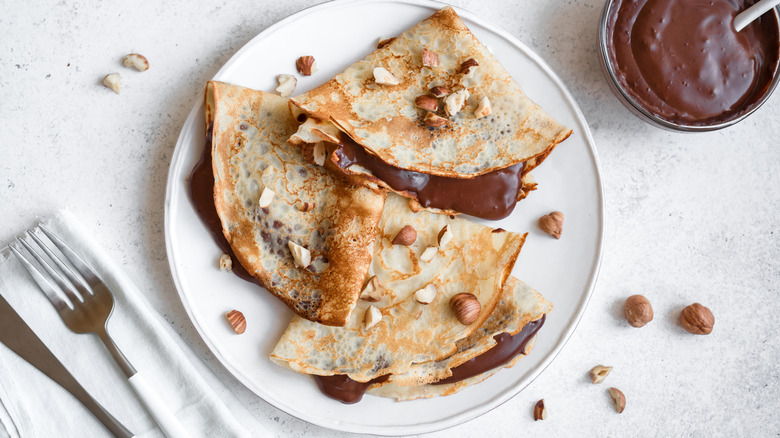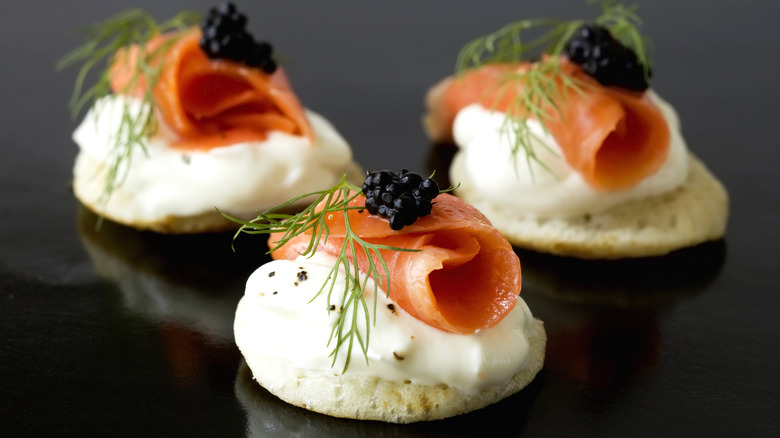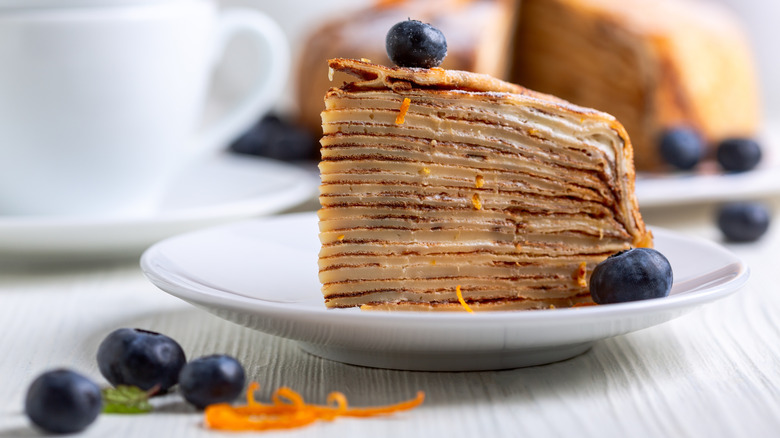Russian Blini Vs French Crepes: How Are These Regional Delicacies Different?
Flatbreads must be a universal culinary creation, or something close to it. Just thinking about the general concept of starch mixed with liquid into a dough, then griddled on a hot surface or baked in the oven, you can come up with several different foods from around the world. Two foods that fall in this category, Russian blini and French crepes, are fancy-ish flatbreads that look similar, combine similar ingredients, and might occasionally be at risk of being mistaken for one another. Not that it would necessarily be a bad thing to have caviar on crepes or to fill your blini with ham and cheese, but there's a meaningful difference between the two.
Start with the ingredients: One key difference is that, while Russian blini rely on yeast to make the batter rise, there's no leavening agent in French crepes. That means that blini tend to be more pancake-like, while crepes tend to be more ... well, crepe-like: silky and ultra-thin. (Blini are distinct from American-style pancakes, meanwhile, because pancakes usually aren't leavened with yeast — they typically rely on baking soda or baking powder.) Cultural backgrounds are just as important as ingredients when discussing the difference between blini and crepes. As with many food preparations that have been around for millennia, the actual origin of each is a bit hazy, but comes with pretty good stories nonetheless.
Russian blini aren't just delicious — they're also party food
Nowadays, blini are consumed year-round in Russia, but they're especially important during Maslenitsa, a weeklong festival occurring in February before the beginning of Russian Orthodox Lent. During Lent, consuming milk, cheese, and other dairy is forbidden. So, like Mardi Gras in New Orleans, Maslenitsa is a big celebration of excess — so much so that other names for it are "Butter Week" and "Cheese Week." ("Maslenitsa" comes from maslo, the Russian word for butter.) And what are folks putting all that butter on? You got it: blini, topped with caviar, sour cream, and other decadent treats.
The blini don't just fill bellies, though — they play an important symbolic role. Because Maslenitsa happens right before spring, the blini are thought to represent the sun, returning after the cold darkness of winter.
What makes blini, blini? At their most basic, they come from a batter classically made with buckwheat flour — though other flours, such as rye and wheat, can be used. Dropped onto a hot surface or baked in the oven, dollops of batter puff up due to the inclusion of yeast. (Blini is the plural, by the way; a single flatbread is called blin, while miniature blini like the ones in this recipe are called blinchiki.) They most famously serve as a platform for sour cream and caviar, though folks also adorn them with sweet toppings like jam or honey. And, as always, butter.
Crepes are super-thin pancakes that can be sweet or savory
As it happens, crepes also have a symbolic significance during a winter holiday: La Chandeleur, or Candlemas, which marks the 40th day after Christmas. Candlemas is observed on February 2, aka Le Jour des Crepes. As with blini in Russia, the round golden crepes eaten all over France on this day are thought to symbolize the return of the sun as winter gives way to spring — though they may represent coins as well.
In one popular origin story, the crepe's creation is credited to a woman who spilled buckwheat porridge onto a hot, flat cooking surface. The fact that many crepes are made with buckwheat flour suggests they might come from Brittany, a region where buckwheat — unlike regular wheat — grows well. But crepes today are not always made with buckwheat — plenty rely on plain old wheat flour.
Unlike puffier blini, crepes are basically very thin pancakes, made from a batter of flour, eggs, and milk, and cooked in a little butter in a pan or on a flat surface. They also can be savory or sweet. Anybody who's wandered around Paris (or an American state fair, for that matter, as crepes have become ubiquitous in the States, too) can tell you that options range from crepes filled with ham and cheese to ones smeared with Nutella or jam and showered in powdered sugar. Beyond simple combos like this, crepes can be turned into something much more elaborate: fancy a multi-layered crepe cake, anyone?


